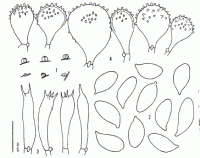|
 Marasmius unilamellatus Marasmius unilamellatus
BiostatusPresent in region - Indigenous. Endemic
Images (click to enlarge)
Caption: Fig. 10 (1-4). Marasmius unilamellatus Desjardin & E. Horak (PDD, holotype).- 1.
Basidiomes.-2. Basidiospores.-3. Basidia.-4. Pileipellis. |
Article: Desjardin, D.E.; Horak, E. (1997). Marasmius and Gloiocephala in the South Pacific Region: Papua New Guinea, New Caledonia, and New Zealand taxa. Bibliotheca Mycologica 168: 152 p.
Description: Pileus 2-3 mm diam, hemispherical to convex, laterally attached to substrate, with a single
transecting shallow groove over lamella; surface dull, dry, glabrous to minutely pruinbse; evenly off
white to beige. Texture membranaceous; context very thin, white.- Lamella only one, adnate at
point of lateral attachment, narrow to moderately broad, white; lamellulae absent-. Stipe
absent.- Odor and taste not distinctive.
Basidiospores 9.0-12.5 x 4.5-5.0 µm, ellipsoid to subfusoid, smooth, thin-walled, hyaline,
inamyloid.- Basidia 30-36 x 7-9 µm, (1-, 2-) 4-spored, cylindrical to subclavate, clamped.-
Cheilocystidia scattered, Rotalis-type cells similar to those on the pileipellis.- Pleurocystidia
absent.Pileipellis hymeniform, composed of Rotalis-type cells; main body (15-) 20--40 x 12-30
µm, broadly clavate to sphaeropedunculate, thin-walled at the base, thick-walled at the apex,
pale yellowish brown; divergent setulae 1-2 x 12 µm, cylindrical.- Tissues inamyloid, non-gelatinous.- Clamp connections present.
Habitat: Habit, habitat and distribution.- Solitary, in groups on rotting leaves of Beilschmiedia tawa
(Lauraceae). New Zealand.
Notes: Marasmius unilamellatus is unusual in the genus in forming basidiomes with a single lamella
extending from the sessile pileus margin to the point of attachment on the substratum. An
undescribed species from the Hawaiian Islands is the only other Marasmius species that shares
this feature, although the Hawaiian species forms a well-developed lateral stipe and grows on
monocotyledous leaves (Desjardin, unpubl. data). It is difficult to determine whether M.
unilamellatus belongs in sect. Marasmius or sect. Hygrometrici, showing anatomical features
consistent with both infrageneric taxa. In the field, M. unilamellatus may appear similar to
several "2-holer" Favolaschia species; however, Favolaschia lacks a pileipellis composed of a
hymeniform layer of Rotalis-type cells.
|